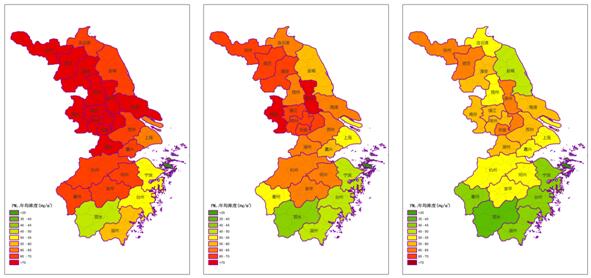Joint effort to fight Delta air pollution: Report
Clean Air Alliance of China, June 17, 2016 Adjust font size:
The Yangtze River Delta cities seek to strengthen their ties in tackling air pollution as they plan to introduce scientific knowledge and management experiences in reducing the concentration of fine particulate matters (PM2.5), says a report issued by the Clean Air Alliance of China (CAAC) on July 13.
Key Conclusions
Yangtze River Delta Zone (hereafter referred to as “the Delta Zone"), covering Shanghai, Jiangsu and Zhejiang, is the top economic zone in China. However, the Delta Zone has been facing a severer environmental situation due frequently occurred air quality incidents in recent years.
In September 2013, the State Council promulgated the Air Pollution Prevention and Control Action Plan (2013-2017) and proposed to reduce the concentration of fine particulate matters in the Delta Zone by about 20% by 2017. According to the National Schedule of Urban AQI Compliance, the Delta Zone has to develop medium-and-long-term plans to reach the targets and make as possible all cities in the Delta Zone meet with the national standard (35 µg/m3 of annual average PM2.5 concentration).

(a) 2013 (b) 2014 (c) 2015
Figure 1. Annual PM2.5 Concentrations in the Cities in Yangtze River Delta Zone, 2013-2015
Based on the medium and long term targets for 2030, this Study conducts scenario analysis on how Shanghai, Jiangsu and Zhejiang to achieve PM2.5 targets by 2030. The analysis results suggest that only implementation of emission reduction measures for maximum potential which are supported by sustainable energy development strategies can ensure full compliance with air quality standards across the Delta Zone. The strategies and measures include:
Adjustment to energy structure and industrial structure, Change of life styles and Improvement of energy efficiency
The share of coal in energy consumption should be cut down by using more clean energy. By 2030, the share of coal in primary energy consumption should be cut down to 52%, the share of natural gas should be increased to 9%, and the share of biomass and other renewable energy sources should be increased to 20%.
The share of coal-fired generation capacity shall be reduced and the efficiency of coal-fired power generation should be improved. By 2030, the share of coal-fired power generation capacity in total power generation capacity should be reduced to 57%. The share of supercritical and ultra supercritical power generation units and integrated gasification combined cycle generating units should be substantially increased.
Best available technologies (BAT) should be widely used in all industries by 2030. Backward and high energy consuming technologies should be replaced by efficient energy technologies. China's energy efficiency should match or catch up the world’s highest level by 2030.
New energy vehicles should be promoted and fuel economy should be improved. By 2030, the shares of hybrid electric cars, plug-in hybrid cars and electric cars among total new cars sold should arrive at 25%, 28% and 2% respectively. By 2030, the fuel economy of new cars and heavy-duty vehicles should be 33% and 57% respectively more than those in 2010 through implementing new fuel economy standards.